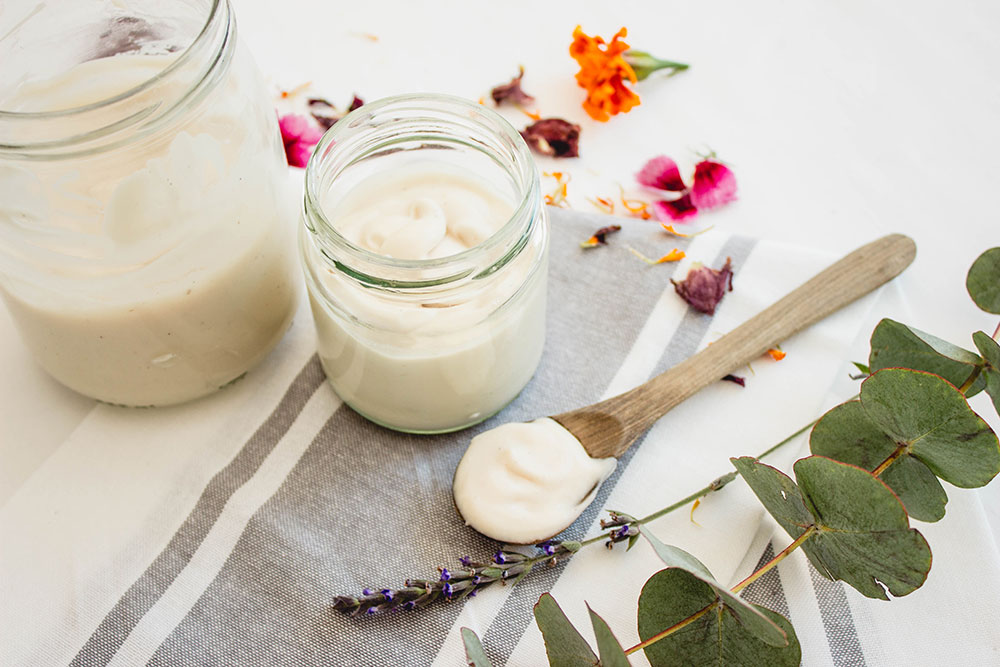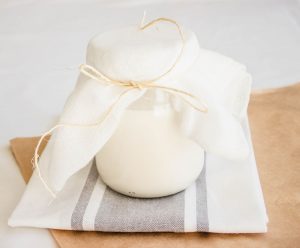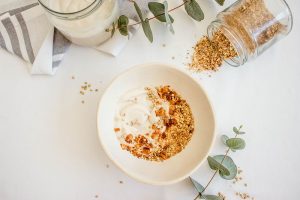
19 Oct Four-Ingredient Dairy-Free Coconut Yoghurt
After making my own coconut yoghurt I’ll never go back to stored bought coconut yoghurt; it’s cheaper and I can control what goes into the yoghurt. This recipe can also be used to make regular yoghurt.
The secret to having creamy, thick and tangy yoghurt lies with the ingredients you use and off course the right method. Agar agar (vegan version of gelatine) and tapioca starch is the best way to thicken coconut yoghurt. When making the yoghurt it is crucial that all pans, jars and utensils are clean (sterilised in boiling water to be sure) to avoid contaminating the yoghurt with bad bacteria (yes, that means no double dipping of your licked spoon).
This recipe is vegan, however just have a look at what probiotic you buy as some do contain a small amount of milk proteins (too small to affect lactose-intolerance), as well as if it’s a veggie capsule. The Metagenics UltraFlora Balance I use is a veggie capsule.
WHAT YOU’LL NEED:

- Wooden spoon and glass jar, sterilised under boiling water
- Cheesecloth or clean dish cloth
- Elastic band or twine
Or - Wooden spoon
- Severin Yoghurt Maker
INGREDIENTS:
- 2 cans full cream coconut milk*
- 4 capsules probiotic (> 10 billion culture)**
- 2 tsp agar agar powder or tapioca starch
- 1 tsp vanilla powder (or extract)
OPTIONAL
- 2 Tbsp sweetener of choice (coconut sugar/maple syrup/honey/date syrup)
- Chopped or stewed fruit
*Coconut milk with minimal ingredients is the best (coconut, water, guar gum) and if organic it’s a bonus, but regular coconut milk also works if you don’t mind the additional ingredients (stabilisers, emulsifiers).
**Be sure to buy the capsules that you can open up to use the probiotic powder inside and discard or reuse the empty capsule shell. Use a probiotic that doesn’t contain prebiotics and does contain anything between 10-15billion cultures or more.
METHOD:
- Sterilise the glass jar by filling it with boiling water in the sink and let it stand for 5-10 minutes.

- In the meantime, pour the coconut milk into a clean saucepan and bring to a simmer. Scoop ¼ cup aside in a small bowl and mix with the agar powder or tapioca starch, then pour the ¼ cup milk that is mixed with the thickener back into the saucepan and mix with the rest of the milk (this is too avoid lumps). Let the milk mixture simmer for 5-10 minutes until it thickens slightly, stir frequently with a wooden spoon.
- Pour the boiling water out of the jar and let it dry on the drying rack or dry with a clean dishcloth.
- Take the saucepan off the stove top and let it cool down slightly before adding in the contents of the probiotic capsules and mixing it in with a wooden spoon. You might experience a few lumps here use the back of the spoon to press them against the sides of the pan to dissolve.
- Mix in vanilla and sweetener, if desired, at this point.
 Pour the yoghurt mixture into the dry, sterilised glass jar and cover with cloth and elastic band. You now need to place the jar in a temperature regulated area; the best place for this is your oven: turn the oven on for 5 minutes on 50 , then turn it off but leave the light on for a little heat and place the jar in the oven for 8-12 hours.If you are using the yoghurt maker, pour into the separate sterilised jars and cover with the lid provided. Switch the yoghurt maker on and place jars inside, leave for 6-8 hours.
Pour the yoghurt mixture into the dry, sterilised glass jar and cover with cloth and elastic band. You now need to place the jar in a temperature regulated area; the best place for this is your oven: turn the oven on for 5 minutes on 50 , then turn it off but leave the light on for a little heat and place the jar in the oven for 8-12 hours.If you are using the yoghurt maker, pour into the separate sterilised jars and cover with the lid provided. Switch the yoghurt maker on and place jars inside, leave for 6-8 hours.- After specified time take out of the oven or yogurt maker, place a lid on the jar and refrigerate for 4-6 hours to thicken further. If you want to add fruit, do that before putting the jar in the fridge.
- Enjoy with a little granola or in this coconut yoghurt pancake recipe or even this Vegan Low carb Strawberry Protein Parfait.

TROUBLE SHOOTING:
Jelly-like, Lumpy: This might occur because you added too much agar powder or tapioca starch, which is perfect if you like super thick yoghurt (almost like moose). Scoop everything into your blender and blend until smooth. Scoop back into jar and store in fridge, it won’t set that much again.
No thickener yoghurt: You can also make a fairly thick yoghurt without using any thickener at all. Instead of using the whole can of coconut milk, just use the extra-thick creamy layer that rises to the top. To do this, refrigerate the can of coconut milk overnight, open the can, and scoop the layer of thick white cream off the top. It’s naturally thick, so there’s no need to add thickening agents to it, and you can also skip the heating step (which makes the process
quicker). Note this yoghurt is incredibly rich, so it’s better as a topping for pancakes or desserts.
For a thicker yoghurt:
- One option for making Greek-style yoghurt is to make tapioca- or agar agar-thickened yoghurt and then strain it through cheesecloth overnight to remove excess water. This also produces a sweet and rich yoghurt and it thicker than the recipe above.
- OR scoop about 1 tablespoon of your fermented yogurt into a small bowl and stir together with 1 teaspoon ground psyllium husk. Pour back into the jar and stir
together well. - OR stir 3 tablespoons of chia seeds into the jar of fermented yogurt. Chill for 4 hours until thickened.
Smells funny: The yoghurt is most likely contaminated by bad bacteria during the process, don’t eat it, discard it.
Not fermented: Leave it for a few more hours and then check if it tastes like yoghurt. If not, it might be the probiotic that you used wasn’t strong enough.



Pingback:Fluffy Coconut Yogurt Pancakes with Rainbow Drizzle - Faithful to Nature Natural and Organic Blog
Posted at 11:08h, 19 October[…] tbsps coconut yoghurt (separated 2 tbsp in each […]
Maureen Cram
Posted at 15:30h, 06 DecemberI think it might have been a more helpful article if you had suggested a vegan probiotic which I understand F2N sells. The one quoted may be in a veggie capsule but is still listed as vegetarian.
Angelique Booyens
Posted at 09:29h, 14 JanuaryHi Maureen, thanks for your comment.
Most probiotics still contain a very, very small amount of lactose, but not enough to have any significant effect if you are lactose intolerant, so for this reason brands cannot list it as vegan. Hope you can find a probiotic listed as vegan at your pharmacy or health store.
Joanne Brown
Posted at 06:57h, 11 AprilUnfortunately I don’t have a yoghurt maker, can I use an instant pot and follow the same steps?